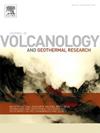酸性温泉和泥塘沉积物碳氮同位素组成生物特征评价
IF 2.3
3区 地球科学
Q2 GEOSCIENCES, MULTIDISCIPLINARY
Journal of Volcanology and Geothermal Research
Pub Date : 2025-06-28
DOI:10.1016/j.jvolgeores.2025.108402
引用次数: 0
摘要
碳(C)和氮(N)同位素已被广泛用作研究有机物来源的生物标志。然而,大量δ13C和δ15N分析在热液环境中没有得到充分利用,这使得与早期地球环境和其他行星材料的相关比较变得困难。因此,在这项研究中,我们研究了大量同位素分析是否可以成功地用于探测热液环境中的微生物特征,类似于地球上生命可能开始的地方。我们分析了冰岛和美国酸性热液沉积物中C和N的浓度和同位素组成。冰岛贫瘠地区温泉和泥沼沉积物的体δ13C值较高(- 25.6 ~ - 14.5‰),而美国森林较多的地区δ13C值较低(- 26.5 ~ - 21.0‰)。冰岛的碳浓度较低(0.13 - 0.55 wt%),而美国的碳浓度较高(0.04 - 4.78 wt%)。体积δ13C的显著负范围表明了在原位(微生物活动)和周围区域(植物生物量生产)发生的生命过程。冰岛沉积物中较高的δ13C与较小的C同位素分异相一致,这与嗜热菌(微生物)活动有关,其中较大的负体δ13C值对应于美国外来植物物质输入的增加。相反,由于不同氮源(如外来植物物质、火山/热液气体和微生物过程)之间的δ15N值重叠,总体δ15N结果(−18.4 ~ +3.7‰)在区分生物特征方面的作用较小。本文章由计算机程序翻译,如有差异,请以英文原文为准。
Evaluating bulk carbon and nitrogen isotope compositions of acidic hot spring and mudpot sediments as biosignatures
Carbon (C) and nitrogen (N) isotopes have been widely used as biosignatures to study the origin of organic materials. However, bulk δ13C and δ15N analyses have been underutilized in hydrothermal settings, making relevant comparisons to early Earth environments and other planetary materials difficult. Therefore, in this study we examined if bulk isotope analysis can be successfully used to detect a microbial signature in hydrothermal environments similar to where life might have begun on Earth. We analyzed concentrations and isotope compositions of C and N within acidic hydrothermal sediments in Iceland and the United States. The measured bulk δ13C of the hot spring and mudpot sediments was higher in barren Icelandic sites (−25.6 to −14.5 ‰) compared to lower values in more forested sites of the United States (−26.5 to −21.0 ‰). These corresponded to lower C concentration in Iceland (0.13 to 0.55 wt%) and higher C concentrations in the United States (0.04 to 4.78 wt%). The distinctive negative ranges of bulk δ13C were indicative of life processes occurring in-situ (microbial activity) and in the surrounding area (production of plant biomass). The higher δ13C of the Icelandic sediments were consistent with smaller C isotope fractionations associated with thermophile (microbial) activity, wherein more negative bulk δ13C values corresponded to increasing input of allochthonous plant matter in the United States. Conversely, the bulk δ15N results (−18.4 to +3.7 ‰) were less useful in differentiating biosignatures because of overlapping δ15N values between various N sources such as allochthonous plant matter, volcanic/hydrothermal gases, and microbial processes.
求助全文
通过发布文献求助,成功后即可免费获取论文全文。
去求助
来源期刊
CiteScore
5.90
自引率
13.80%
发文量
183
审稿时长
19.7 weeks
期刊介绍:
An international research journal with focus on volcanic and geothermal processes and their impact on the environment and society.
Submission of papers covering the following aspects of volcanology and geothermal research are encouraged:
(1) Geological aspects of volcanic systems: volcano stratigraphy, structure and tectonic influence; eruptive history; evolution of volcanic landforms; eruption style and progress; dispersal patterns of lava and ash; analysis of real-time eruption observations.
(2) Geochemical and petrological aspects of volcanic rocks: magma genesis and evolution; crystallization; volatile compositions, solubility, and degassing; volcanic petrography and textural analysis.
(3) Hydrology, geochemistry and measurement of volcanic and hydrothermal fluids: volcanic gas emissions; fumaroles and springs; crater lakes; hydrothermal mineralization.
(4) Geophysical aspects of volcanic systems: physical properties of volcanic rocks and magmas; heat flow studies; volcano seismology, geodesy and remote sensing.
(5) Computational modeling and experimental simulation of magmatic and hydrothermal processes: eruption dynamics; magma transport and storage; plume dynamics and ash dispersal; lava flow dynamics; hydrothermal fluid flow; thermodynamics of aqueous fluids and melts.
(6) Volcano hazard and risk research: hazard zonation methodology, development of forecasting tools; assessment techniques for vulnerability and impact.

 求助内容:
求助内容: 应助结果提醒方式:
应助结果提醒方式:


